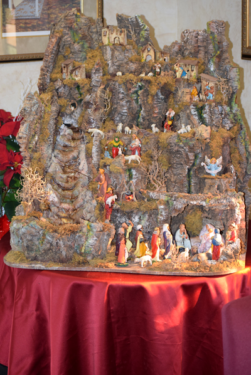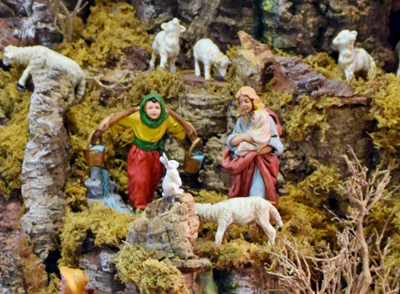My dear brothers and sisters in the Lord,
 St. Francis of Assisi is credited with having established the custom of the placing of the Child Jesus in a crèche, or presepio as it is called in Italian. The first presepio was assembled in the town square of Assisi where people and live animals depicted the birth of Jesus Christ.
St. Francis of Assisi is credited with having established the custom of the placing of the Child Jesus in a crèche, or presepio as it is called in Italian. The first presepio was assembled in the town square of Assisi where people and live animals depicted the birth of Jesus Christ.
Live presentations of the Christmas scene are not as common as the various artistic presentations of Christmas crèches or presepio. Perhaps the most famous and stylized is the Neapolitan presepio which has built on the centuries-old tradition of St. Francis.
In the City of Naples, there is almost a year-round industry making crèches and figurines. There is a whole section of what is known as “spacca Napoli” where you can buy almost any kind of Christmas crèche. Several years ago, I was in Naples around Christmastime and a priest friend of mine showed me the incredible network of cottage industries that make the Christmas scenes.
The most stylized representation of the Nativity and Incarnation event is usually a three-tiered Christmas scene. At the top tier, there is usually a scene of destruction of a Roman temple including pagan gods, toppled from the pedestals signifying the destruction of paganism. By Christ’s birth, a new world order was established.
 On the middle tier of the three-tiered presepio is a typical village, representative of the world. The village is somewhat anachronistic in that it is usually the scene of an Italian village with people going about their daily chores. There is plenty of representation of people working with food, people baking bread, slicing salami, or hanging provolone in their houses.
On the middle tier of the three-tiered presepio is a typical village, representative of the world. The village is somewhat anachronistic in that it is usually the scene of an Italian village with people going about their daily chores. There is plenty of representation of people working with food, people baking bread, slicing salami, or hanging provolone in their houses.
It seems that the daily events of life are unaffected by the third tier of the Nativity scene itself, with the Child Jesus, Mary and Joseph, along with the shepherds, wise men and barnyard animals who witness the birth of the Savior.
Could it be, however, that we also go about our lives without reference to the event of the Incarnation which we have celebrated?
How do we appr opriate the Incarnation event as our own? How can we accept the humanity and divinity of Christ, while at the same time accepting our own humanity which has been touched by sin, yet redeemed by Christ?
opriate the Incarnation event as our own? How can we accept the humanity and divinity of Christ, while at the same time accepting our own humanity which has been touched by sin, yet redeemed by Christ?
Does His Incarnation make us capable of overcoming sin and ultimately death, and does it really establish a new world order?
This is the challenge that faces us as we enter a New Year of 2019. We cannot accept Christ’s birth unless we recognize in our own lives what that birth has come to mean to us. We must ask ourselves the question – are we convinced that the birth of the Christ Child over 2,000 years ago really changed the world once and for all? Or are we condemned to the same old patterns of the past? Or worse, do we live as pagans not recognizing that the Incarnation has taken place?
As we put out into the deep of 2019, the memory and reality of the Christmas event must guide us to make the necessary changes in attitude for us to enjoy the peace that Jesus, the Prince of Peace, has won for us by His birth, death and resurrection.
May our New Year’s resolutions this year bring us to recognize that Christ’s birth has changed the world and that we can change also.
